|
Related FAQs:
Nudibranchs,
Nudibranchs 2, Nudibranch Identification,
Nudi ID 2, Nudi ID 3, Nudi ID 4, & Nudibranch Behavior,
Nudibranch Compatibility,
Nudibranch Selection,
Nudibranch Systems,
Nudibranch Feeding,
Nudibranch Disease,
Nudibranch
Reproduction, Berghia
Nudibranchs, Marine Snails
1, Marine Snails
2, Marine Snails
3, Marine Snails
4, Sea Slugs,
Seaslugs 2,
Snail ID
1, Snail ID 2,
Snail ID
3,
Related Articles: Dorid et al. Nudibranchs pt. 2,
Aeolid Nudibranchs pt.
3, Sea
Slugs, Gastropods, Mollusks,
Aiptasia/Glass
Anemones
/The Conscientious Marine
Aquarist
Nudibranchs, The
Naked-Gill Sea Slugs, pt. 13, Aeolids
To: Pt. 1,
Pt. 2, Pt.
3,
Pt. 4,
Pt. 5,
Pt. 6,
Pt. 7,
Pt. 8, Pt. 9,
Pt. 10, Pt. 11,
Pt. 12, Pt. 14,
Pt. 15, Pt. 16
|
|
|
By Bob Fenner |
|
Suborder Aeolidacea, Aeolids:
('Eye-Oh-Lidz'), (sometimes Aeolids, Suborder Aeolidacea)
have clusters of elongated dorsal structures, the cerata provide cryptic architecture, making them look like
sea anemones when balled up. The cerata serve several other functions;
as a respiratory surface, in some species each containing a glandular
digestive lobe; and very importantly for marine aquarists they may
contain specialized cnidosomes. Take a good
look at that word. Sounds a lot like the stinging cells of Cnidarians
(Coelenterates) (anemones, corals, jellyfish...) for good reason. These
Nudibranch species store undischarged nematocysts from feeding on the
animals that produce them. If these transplanted weapons on their backs
weren't enough, some Aeolids pack poisonous glands, spiky bundles
of calcareous spicules or noxious mucus secretions as well. No wonder
they're not often eaten.
In addition to the pair of rhinophores that Dorids possess, Aeolids sport a pair of
oral tentacles and parapodial
tentacles. Their body and foot are generally more elongated and
narrower, especially tapering posteriorly, than the Dorids.
Family Facelinidae:
| Caloria indica (Bergh 1896). Likely the
most common member of the family in the Indo-Pacific. Orange head,
body with white and yellow markings. Cerata blue, yellow and red
striped. Raja Ampat 08. |
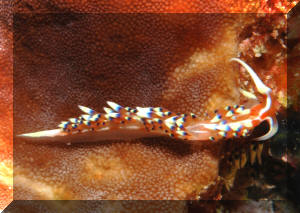
|
| Phidiana indica (Bergh 1896).
Feeds on Hydroids. Indo-Pacific; Red Sea, East Africa to Japan. N.
Sulawesi (Lembeh Strait) pix. To 5 cm. |
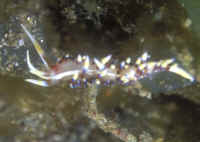
|
Bigger PIX:
The images in this table are linked
to large (desktop size) copies. Click on "framed" images
to go to the larger size. |
|

|
| Phidiana lynceus Bergh 1867. Brazil to
Florida. To 1.25"/30mm. Here in Cozumel. |
.JPG)
|
Bigger PIX:
The images in this table are linked
to large (desktop size) copies. Click on "framed" images
to go to the larger size. |
|
%20MD.JPG)
|
Genus Phyllodesmium:
Bigger PIX:
The images in this table are linked
to large (desktop size) copies. Click on "framed" images
to go to the larger size. |
|
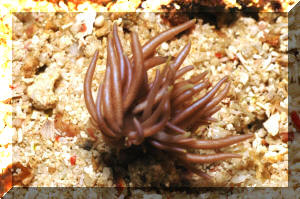
|
| Phyllodesmium crypticum, Rudman 1981. Tapering
tubercles with cerata showing branching digestive glands inside. KBR |
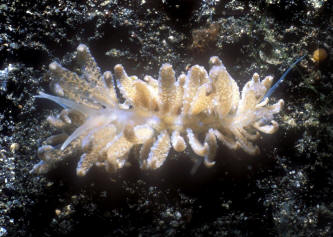
|
Bigger PIX:
The images in this table are linked to large (desktop size) copies.
Click on "framed" images to go to the larger size. |
%20MD.JPG) |
| Phyllodesmium hyalinum Ehrenberg 1831. 45 mm. Feed
on Corals, esp. Xeniids. Red Sea, I.O. to W. Pacific. A trio on Tubipora
musica here in Bali 2014 |
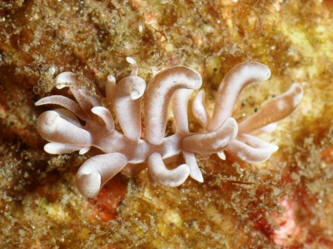
|
Bigger PIX:
The images in this table are linked to large (desktop size) copies.
Click on "framed" images to go to the larger size. |
%20MD.JPG) |
Bigger PIX:
The images in this table are linked to large
(desktop size) copies. Click on "framed" images to go to
the larger size. |
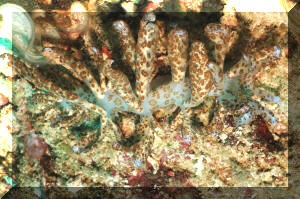
.JPG) |
To: Pt. 1,
Pt. 2, Pt.
3,
Pt. 4,
Pt. 5,
Pt. 6,
Pt. 7,
Pt. 8, Pt. 9,
Pt. 10, Pt. 11,
Pt. 12, Pt. 14,
Pt. 15, Pt. 16
|
|

